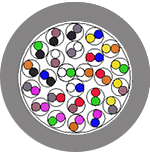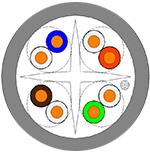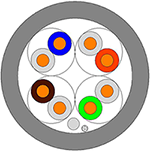|
CATEGORY 3 CABLE
Its a type of unshielded twisted pair (UTP) cable that is used for voice and data communications in computer and telecommunication networks. It is an Ethernet copper cable was one of the most popular data communication cables used in 10Base-T and token ring networks from which it has the ability to transmit data at a speed of 10 Mbps. When implemented in 100BaseT networks, a Cat 3 cable can carry data at speeds much higher than its base speed. The cable delivers good voice communication performance because it provides 16 MHz of bandwidth, which is more than enough for phone calls. It is also popular in network environments where electromagnetic interference is of minimal concern. |
 |
|
CATEGORY 5e CABLE
It’s a type of unshielded/shielded twisted pair (UTP/FTP) cable that is used extensively in Ethernet connections in local networks, as well as telephony and other data transmissions. The cable employs a twisted pair design, rather than a coaxial cable or a fiber-optic cable design. As technology for twisted pair copper cabling has progressed, successive categories have given user more modern choices. The cable offer more potential for bandwidth and better potential handling of signal noise or loss & delivers good voice communication performance because it provides 100 MHz of bandwidth. |
 |
|
| |
CATEGORY 6 CABLE
Its a type of unshielded/shielded twisted pair (UTP/FTP) cable that is used extensively in Ethernet connections in local networks, as well as data transmissions. This cable provides a significant improvement in performance over Cat5 and Cat 5e. The shielding protects the twisted pairs of wires inside the Ethernet cable, helping to prevent crosstalk and noise interference. The Cat.6 cables can technically support at bandwidth 250MHz, speeds up to 10 Gbp/s to 165 feet (55 meters). |
 |
|
| |
CATEGORY 6A CABLE
Its a type of shielded twisted pair (FTP) cable that is used extensively in Ethernet connections in local networks, as well as data transmissions. This cable provides a significant improvement in performance over Cat.6 cable. The shielding protects the twisted pairs of wires inside the Ethernet cable, helping to prevent crosstalk and noise interference. The Cat.6A cables can technically support at bandwidth 500MHz, speeds allows up to 10 Gbp/s to 328 feet (100 meters) that makes them relatively long Ethernet cables & less in heavy cross talk environments. |
 |
|